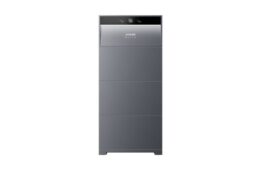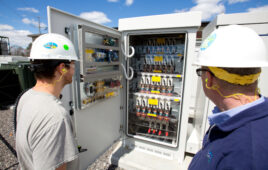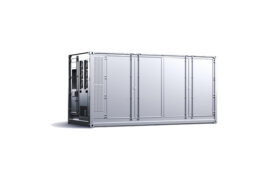The assets of Storion Energy, a vanadium redox flow battery (VRFB) technology company, have been purchased by Stryten Energy, an energy storage solution provider. Storion’s VRFB technology is ideal for applications that require more than four hours of storage capacity to deploy clean energy on demand from renewable sources such as solar and wind energy. These applications include utility-scale storage, microgrids and military bases.
 “The acquisition of Storion will add a flow battery technology R&D facility to complement Stryten’s four North American R&D centers focused on advanced lead and lithium energy storage solutions for our essential power, motive power, transportation, military and government customers,” said Mike Judd, President and Chief Operating Officer of Stryten Energy. “The combination of Stryten’s team of 2,500 employees and our more than 2 million sq. ft of manufacturing space brings the industrial resources necessary to establish a reliable supplier of long-duration batteries that are engineered and produced in the U.S.”
“The acquisition of Storion will add a flow battery technology R&D facility to complement Stryten’s four North American R&D centers focused on advanced lead and lithium energy storage solutions for our essential power, motive power, transportation, military and government customers,” said Mike Judd, President and Chief Operating Officer of Stryten Energy. “The combination of Stryten’s team of 2,500 employees and our more than 2 million sq. ft of manufacturing space brings the industrial resources necessary to establish a reliable supplier of long-duration batteries that are engineered and produced in the U.S.”
Storion’s proprietary VRFB design solves the energy-to-power tradeoff for batteries. Batteries available today have the potential to provide standby power for longer durations when operated at a fraction of the battery’s power rating. In contrast, Storion’s VRFB technology expands a battery’s capabilities to operate for many hours without sacrificing its power or the speed at which it can release energy, by simply adding more electrolytes to the system.
Storion’s VRFB combines multiple innovations to achieve pioneering energy storage performance enabling expanded use of renewables, including:
- Domestically sourced vanadium that is easily recycled
- Increased power density and reduced battery downtime
- Potential of limitless cycle life with proper maintenance
- High-temperature ratings and thermally safe
- Scalable to meet varying energy storage capacity needs
“We are excited to welcome the talented Storion team to Stryten Energy,” said Tim Vargo, Chief Executive Officer of Stryten Energy. “The clean energy transition in the U.S. requires reliable battery solutions across multiple chemistries to meet the growing demand for renewable power. The addition of Storion’s proprietary vanadium redox flow battery technology to Stryten’s Essential Power portfolio of energy solutions will expand our capabilities to solve our country’s current and future energy challenges, while positioning Stryten for success in the rapidly growing long-duration energy storage market.”
Storion’s VRFB technology will expand the portfolio of Stryten’s newly formed Essential Power division, which provides a suite of advanced lead and lithium battery technologies and services, including chargers and racking systems, used for backup power for the military and government, telecommunications, uninterruptible power supply (UPS), railway, utility, microgrid and renewable markets with the addition of long-duration energy storage capabilities.
News item from Stryten





“Batteries available today have the potential to provide standby power for longer durations when operated at a fraction of the battery’s power rating.”
Usually from 15% SOC to 90% SOC or the typical 20% SOC to 80% SOC. The 60% of battery capacity is still better than the 50% or less capacity used in lead/acid energy storage systems. There is still this persistent paradigm that lithium ion can only be designed for 4 hours of energy storage. This is a lie the utility willingly tells itself as it desperately tries to hold on to a uni-directional grid and the “regulated monopoly” that sustains the utility. Partnerships and EaaS, Energy as a Service is the last thing utilities want to do. Electrical Engineers design series and (parallel) systems that sync together to create higher power electronics all the time. Being able to (matrix) power blocks of 10MW/40MWh blocks into a matrix that can be set up for parallel operation can create something that can be switched into the grid at 10MWh for around 3 hours, matrix many of these power blocks and sequence through each power block one could have 10MWh of generation out for 30 hours or 20MWh for 15 hours or 30MWh for 9 hours. How many power blocks does one need and how does one “matrix” them to feed the grid?
After company A123 filed for bankruptcy and a portion of the company was sold off, the principles of A123 formed company 24M (24 Molar). Their first attempt at a “new” energy storage system was redox flow batteries. At the time 24M was pondering this, they also realized there were no tools to analyze the cost and size of system design that would break into the “economies of scale” price point. So, those working at 24M created their own analysis tool and determined that at 1GWh energy storage redox flow batteries are right around $1/watt. This is the scale of redox flow battery that would do well for regional energy storage along transmission lines and large-scale solar PV farms and wind farms. The question is, who will be first to do this kind of design and implementation? It sounds like Storion has the redox flow battery chops, and Stryten has the R&D ESS experience to do many things. Like hybrid lithium ion and redox flow battery combinations and matrixing technologies to meet many grid services with one asset.